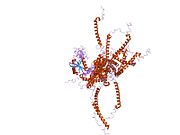Biology:Ubiquitin B
 Generic protein structure example |
Ubiquitin is a protein that in humans is encoded by the UBB gene.[1]
Function
Ubiquitin is one of the most conserved proteins known in eukaryotic organisms. Ubiquitin is required for ATP-dependent, non-lysosomal intracellular protein degradation of abnormal proteins and normal proteins with a rapid turnover. Ubiquitin is covalently bound to proteins to be degraded, and presumably labels these proteins for degradation. Ubiquitin also binds to histone H2A in actively transcribed regions but does not cause histone H2A degradation, suggesting that ubiquitin is also involved in regulation of gene expression. This gene consists of three direct repeats of the ubiquitin coding sequence with no spacer sequence. Consequently, the protein is expressed as a polyubiquitin precursor with a final amino acid after the last repeat. Aberrant form of this protein (UBB+1) has been noticed in patients with Alzheimer's disease, Down syndrome, other tauopathies (e.g. Pick's disease) and polyglutamine disease (e.g. Huntington's disease).[2][3]
References
- ↑ "Localization of the human UbB polyubiquitin gene to chromosome band 17p11.1-17p12". Am J Hum Genet 46 (2): 308–15. Mar 1990. PMID 2154095.
- ↑ "Disease-specific accumulation of mutant ubiquitin as a marker for proteasomal dysfunction in the brain". FASEB J 17 (14): 2014–2024. Nov 2003. doi:10.1096/fj.03-0205com. PMID 14597671.
- ↑ "Entrez Gene: UBB ubiquitin B". https://www.ncbi.nlm.nih.gov/sites/entrez?Db=gene&Cmd=ShowDetailView&TermToSearch=7314.
Further reading
- "Emerging roles of ubiquitin in transcription regulation". Science 296 (5571): 1254–1258. 2002. doi:10.1126/science.1067466. PMID 12016299. Bibcode: 2002Sci...296.1254C.
- "New roles for ubiquitin in the assembly and function of neuronal circuits". Neuron 36 (1): 5–8. 2002. doi:10.1016/S0896-6273(02)00943-1. PMID 12367500.
- "The role of viral and cellular proteins in the budding of human immunodeficiency virus". Acta Virol. 50 (2): 75–85. 2006. PMID 16808324.
- "Molecular conservation of 74 amino acid sequence of ubiquitin between cattle and man". Nature 255 (5507): 423–4. 1975. doi:10.1038/255423a0. PMID 1128706. Bibcode: 1975Natur.255..423S.
- Adams SM; Sharp MG; Walker RA et al. (1992). "Differential expression of translation-associated genes in benign and malignant human breast tumours". Br. J. Cancer 65 (1): 65–71. doi:10.1038/bjc.1992.12. PMID 1370760.
- Pancré V; Pierce RJ; Fournier F et al. (1991). "Effect of ubiquitin on platelet functions: possible identity with platelet activity suppressive lymphokine (PASL)". Eur. J. Immunol. 21 (11): 2735–41. doi:10.1002/eji.1830211113. PMID 1657614.
- "The human ubiquitin-52 amino acid fusion protein gene shares several structural features with mammalian ribosomal protein genes". Nucleic Acids Res. 19 (5): 1035–1040. 1991. doi:10.1093/nar/19.5.1035. PMID 1850507.
- "Ubiquitin mRNA is a major stress-induced transcript in mammalian cells". Nucleic Acids Res. 17 (3): 1215–1230. 1989. doi:10.1093/nar/17.3.1215. PMID 2537950.
- Lund PK; Moats-Staats BM; Simmons JG et al. (1985). "Nucleotide sequence analysis of a cDNA encoding human ubiquitin reveals that ubiquitin is synthesized as a precursor". J. Biol. Chem. 260 (12): 7609–13. doi:10.1016/S0021-9258(17)39652-7. PMID 2581967.
- "Cloning and sequence analysis of a cDNA encoding poly-ubiquitin in human ovarian granulosa cells". Biochem. Biophys. Res. Commun. 147 (2): 581–587. 1987. doi:10.1016/0006-291X(87)90970-3. PMID 2820408.
- Wiborg O; Pedersen MS; Wind A et al. (1985). "The human ubiquitin multigene family: some genes contain multiple directly repeated ubiquitin coding sequences". EMBO J. 4 (3): 755–9. doi:10.1002/j.1460-2075.1985.tb03693.x. PMID 2988935.
- "The human ubiquitin gene family: structure of a gene and pseudogenes from the Ub B subfamily". Nucleic Acids Res. 15 (2): 443–463. 1987. doi:10.1093/nar/15.2.443. PMID 3029682.
- "Structure of ubiquitin refined at 1.8 A resolution". J. Mol. Biol. 194 (3): 531–544. 1987. doi:10.1016/0022-2836(87)90679-6. PMID 3041007.
- Busch H (1984). "[23] Ubiquitination of Proteins". Ubiquitination of proteins. Methods in Enzymology. 106. 238–262. doi:10.1016/0076-6879(84)06025-0. ISBN 978-0-12-182006-0.
- "Protein A24 lyase activity in nucleoli of thioacetamide-treated rat liver releases histone 2A and ubiquitin from conjugated protein A24". Biochemistry 20 (5): 1100–1104. 1981. doi:10.1021/bi00508a009. PMID 6261785.
- "Ubiquitin - protein conjugates". Mol. Cell. Biochem. 40 (3): 173–87. 1982. doi:10.1007/bf00224611. PMID 6275256.
- "Ubiquitin-dependent c-Jun degradation in vivo is mediated by the delta domain". Cell 78 (5): 787–798. 1994. doi:10.1016/S0092-8674(94)90502-9. PMID 8087846.
- "Structure of tetraubiquitin shows how multiubiquitin chains can be formed". J. Mol. Biol. 236 (2): 601–609. 1994. doi:10.1006/jmbi.1994.1169. PMID 8107144.
- Ramage R; Green J; Muir TW et al. (1994). "Synthetic, structural and biological studies of the ubiquitin system: the total chemical synthesis of ubiquitin". Biochem. J. 299 (1): 151–8. doi:10.1042/bj2990151. PMID 8166633.































































